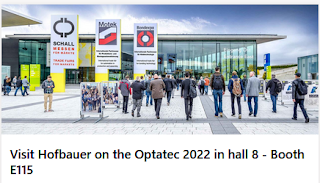Thank you for visiting our booth at OPTATEC 2022 in
Frankfurt. Our new measuring device for measuring aspheres, also on
both sides, met with great interest! We would be happy to send you the
relevant documents!
Friday 21 October 2022
Friday 30 September 2022
Do not miss our lecture about Asphere centering measurement - both sides, too on 2022, Oct. 19th, 11:40 o'clock!
The Optatec international trade fair for optical technologies, components and systems will open its doors at its usual venue in Frankfurt from the 18th through the 20th of October, 2022. The significance of this leading trade is once again substantiated by the fact that more than 45% of all currently registered exhibitors come from outside of Germany. Nowhere else do experts, manufacturers and users of optotechnology and image processing meet in such a focused manner as at Optatec.
Production and quality assurance managers, as well as manufacturing directors and system integrators, are once again looking forward to Optatec 2022 as a key trade fair for the optotechnology and machine vision sectors. They’re able to gain a comprehensive impression of worldwide offerings for products, stand-alone and system solutions, as well as applications including optical components, optomechanics, optoelectronics, fibre-optics, fibre-optic cables, laser components and manufacturing systems. Optatec, which is taking place for the 15th time this year, has established itself as an exclusive industry meet – small, impressive and highly specialised. Expert visitors with decision-making competence meet up here with specialists from various fields and discover concentrated, state-of-the-art, future-oriented offerings. Trade fair visits are made use of to address precisely specific target groups and they make it much easier to arrive at investment decisions.
Thursday 15 September 2022
EurA Photonic Days from 2022, 25.-26th October
The EurA Phontonic Days take place in Fichtenau-Neustädtlein.
Don't miss our very interesting presentation on "asphere centering - also on both sides" from Dr.-Ing. Engelbert Hofbauer!
Click here for registration:
Wednesday 7 September 2022
Monday 2 May 2022
LASER World fo Photonics 2022
Thank you for your visit at our booth, the interesting conversations and the and the associated upcoming new projects! Please contact us, if you have any questions for our new measurement device ELWLAN or MZM for centering measurement.
Saturday 23 April 2022
Absolutely wireless! The new wireless angle and positon sensor ELWLAN
Technical surfaces are currently measured using the classic principle of inclination measurement, preferably with an autocollimator and plane mirror. HOFBAUER OPTIK Mess- & Prüftechnik has also developed the absolute straightness measurement with a wireless reflector using the height method. The easy to use ELWIMAT® has already been tested and is a sales success.
Now there is an innovation: the wireless ELWIMAT®-sensor ELWLAN! This means that not only the reflector is wireless, but also the measuring head.
Angle and position measurements can now also be carried out in inaccessible and critical places without "cable clutter" made with highest precision.
The data is transferred via WLAN to the app on the smartphone, tablet or WINDOWS PC, where it is displayed and evaluated. Complete work processes such as for example straightness measurement can be made komplett in the most remote places on machines and systems - and all without annoying, disruptive cable connections!
The safety aspect is of course an important factor here: No more tripping over cables, no more dirty, damaged or broken cables!
The range with line of sight is approx. 150 m.
The battery life is approx. 3 hours in the small version and up to 6 hours in the power version. You can then work with a power bank or charge the internal battery from the mains.
The connection is made via the integrated WLAN hotspot. Of course, the sensor can also be integrated into an existing network infrastructure as a WLAN client or via a LAN cable.
Come and visit us at LASER in München, Hall B6 Booth 245!Thursday 10 March 2022
Thursday 24 February 2022
Does the history of centering measurement technology on aspheres have to be rewritten, or at least does the DIN ISO 10110-6 standard have to be revised?
As expected and based on experience, the surface shapes of aspheres are significantly worse than those of spheres.
On the one hand, this includes larger long-wave figure errors of up to several micrometers, as well as medium-frequency errors (MSFE) in the frequency range of 0.1 to 1 per millimeter. The MSFE error images contain structures in the form of spokes and as so-called "onion rings". In our example for a 22 mm Forbes asphere, both error patterns are contained slightly. The surface topography shows a low-pass filtered image that corresponds to the footprint of a scanning beam of about 1 mm. Just as we get with our ELWIMAT-V-SPOT 46/40 F#5.6 with a corresponding attachment lens f' = 200 mm on a nominal test object radius of around 20 mm. The amplitude of the IRR (irregularity function) is approx. 75 nm after correction of the SAG portion. The indicated spokes show an increased omega-12 portion. A kind of double sobrero is layered radially. The question is, how this non-ideal asphere surface can be subjected to a "proper" centering measurement and "clean" centering evaluation. As the attentive observer can easily see, the center of the lens has an asymmetrical dip with a diameter of around one to two millimeters. In addition, this dip is slightly offset to the center (estimated 50-100 µm?). How is centering measured here? Which parts of the asphere are considered? What role does the apex play when point sensors cannot resolve it with the required resolution of 1 wsec (5 nm per 1 mm rise length) and autocollimators have a spot diameter (footprint) of at least 3 to 5 mm at the apex and can't resolve it locally?
Join the discussion. We look forward to hearing about your approaches and proposed solutions.








